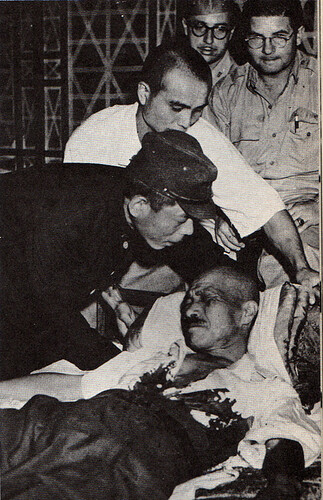Yes, my dear Mr. Rudeerude – without any doubt, you can eliminate the USN. But the Royal Navy definitely cannot be excluded from this story! 
Looks like we need some clues Librarian? Is this ship a J,K class Destroyer from the RN? Is this ship in ruff seas or listing
You are on the right track, my dear Mr. Ruderude: yes, this sinking ship indeed was a K-class destroyer, furthermore – a famous flotilla leader, whose well-known and truly outstanding commander was a member of the House of Lords! 
Would this particular aristocrat be the son of the chap who was forced to resign as First Sea Lord for being excessively German during WW1? If so, that hint is a bit too good!
This is the sinking of HMS Kelly commanded by Lord Louis Mountbatten.Lost in action during the Battle of Crete,and some more info courtesy of wikipedia.
On 23 May 1941, during the evacuation of Crete, Kelly was bombed and sunk, with half her crew killed. Kelly did succeed in shooting down one of the attacking Stukas immediately, while another was badly damaged and crashed upon returning to base.The survivors were deeply affected by the loss of their ship; Mountbatten shared their loss and tried to console the ship’s company by reminding them all that “we didn’t leave the Kelly, the Kelly left us!”
HMS Kelly (pennant number F01) was a K-class destroyer of the British Royal Navy, and flotilla leader of her class.She was named after Admiral of the Fleet Sir John Kelly. She served through the early years of the Second World War; in Home Waters, off Norway and in the Mediterranean. Throughout her service, Kelly was commanded by Lord Louis Mountbatten. She was lost in action in 1941 during the Battle of Crete. In addition, Mountbatten served as commander (Captain (D)) of the 5th Destroyer Flotilla.
Well, my dear Mr. Pdf 27, although father of our fellow was forced to give up his job as early as 1914, it seems to me that this tiny hint was quite sufficient for our esteemed Mr. Rudeerude, who successfully solved this photographic mystery. 
BTW: Certain traditionally well informed personalities were absolutely sure in those times that his destiny actually was induced by some kind of his quite perplex prodigality - especially his inclination to keep porcelain that graced the place of the Celestial Emperor cheek by jowl with the finest china of Meissen and Sèvres. The English, as they commonly do with things they enjoy but are ashamed of, spoke of it as a French invention called Haute Intrigue, or dissemination of pure, unadulterated nonsense – not lies, not truth, not lies mingled with truth, but simply a mass of chaotic words in which the lonely figure of honor, like our beloved Prince Louis Alexander of Battenberg, was obliged to sink and drown in the constantly upward-streaming society. Well, that’s life… 
Of course, this is a completely different thread. Therefore, yet again – my sincerest congratulations, Mr. Rudeerude. We are awaiting your kind offer. 
Oh, I knew who it was, I just didn’t want to risk having to put a photo up 
Hideki Tojo at his home, Setagaya, Tokyo, Japan, 11 September 1945, after shooting himself in the chest in an unsuccessful suicide attempt when Americans came to arrest him.
He used a pistol because he didn’t have an assistant present to behead him after cutting his abdomen open, although he had the swords available as shown here in a picture taken around the same time from a different angle:A Japanese doctor is trying to staunch the flow of blood from the... News Photo - Getty Images
He is reported to have said that he shot himself in the chest instead of the head, although other military leaders shot themselves in the head when they lacked an assistant for traditional suicide, because he “didn’t want to mess up his head”.
Correct RS your up.
Thanks.
It was a bit too easy for me after my earlier one about the American soldier who gave blood to Tojo. What gave it away for me was the recollection that Tojo had shot himself in the chest. I confess that I probably wouldn’t have identified Tojo from the picture without the location of the injury and without the presence of Americans in the background.
Next mystery: What happened here was a turning point in the war.

- Western Front, WW1?
- 1914 or 1918?
Looks like it, doesn’t it?
But no.
WWII.
And not Europe / Mediterranean.
They didn’t use the white things on the trees in WWI for the purpose they were used here.
Which in turn probably makes it New Guinea…
Nope.
But the commander who was responsible for the victory in the photo recognised the significance of the Australian victory at Milne Bay in 1942 as showing that the Japanese could be defeated by steadfast forces, and then he went on to develop tactics in his own theatre which did that on a much larger scale.
Would the commander in question go on to be Governor-General of your unruly mob later in life?
This is turning from a photo quiz into twenty questions!
He was a Governor-General of Australia after the war, but I am mystified by your reference to our unruly mob. 

Kohima?
Yes, but for the 110% mark and the special prize of a jar of unbranded Oxford marmalade, what part of Kohima?

